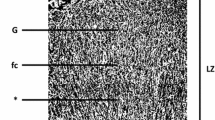Abstract
Objective
To determine the incidence of cellular proliferation in the placenta throughout the three trimesters of normal pregnancy, and in the third trimester of pregnancy complicated by intrauterine growth restriction (IUGR).
Methods
Placental samples were obtained from 17 first-trimester pregnancies, 9 second-trimester pregnancies, 33 uncomplicated third-trimester pregnancies, and 21 third-trimester pregnancies complicated by IUGR. These samples were then stained by immunohistochemical technique, using the monoclonal antibody MIB-1.
Results
The incidences of cellular proliferation in the four groups were as follows: first trimester (n = 17): 11.8% of cells (8.51-17.04); second trimester (n = 9): 9.88% of cells (5.04-10.99); normal third trimester (n = 33): 3.15% of cells (2.07-3.7); IUGR third trimester (n = 21): 3.7% of cells (3.02-4.85). The decline in cellular proliferation throught the three trimesters of pregnancy was statistically significant (P < .0001 Kruskall-Wallis test). The Spearman rank correlation for prliferative index against gestational age had a P value less than .0001 (Rho corrected for ties = -0.81). There was no statiastically significant difference in the incidence of cellular proliferation between normal third-trimester and IUGR third-trimester samples.
Conclusion
The incidence of cellular proliferation in the placenta declines as pregnancy progresses, a finding that agrees with previous work by others. The incidence of cellular proliferation was not altered in cases of IUGR.
Similar content being viewed by others
References
Kerr JFR, Wylie AH, Currie AR. Apoptosis: a basic biological phenomenon with wide-ranging implications in tissue kinetics. Br J Cancer 1972;26:239–57.
Nelson DM. Apoptotic changes occur in syncytiotrophoblast of human placental villi where fibrinoid is deposited at discontinuities in the villous trophoblast. Placenta 1996;17:387–91.
Smith SC, Symonds EM, Baker PN. Placental apoptosis in normal human pregnancy. Am J Obstet Gynecol 1997;177:57–65.
Smith SC, Symonds EM, Baker PN. Increased placental apoptosis in intrauterine growth restriction. Am J Obstet Gynecol 1997;177:1395–1401.
Thompson CB. Apoptosis in the pathogenesis and treatment of disease. Science 1995;267:1456–62.
Savill J. Review: apoptosis in disease. Eur J Clin Invest 1994;24: 715–23.
Ellis RE, Yuan J, Horvitz HR. Mechanisms and functions of cell death. Ann Rev Cell Biol 1991;7:663–98.
Coles HSR, Burne JF, Raff MC. Large-scale normal cell death in the developing rat kidney and its reduction by epidermal growth factor. Development 1993;118:777–84.
Wilcox MA, Johnson IR, Maynard PV, Smith SJ, Chilvers CED. The individualised birthweight ratio: a more logical outcome measure of pregnancy than birthweight alone. Br J Obstet Gynaecol 1993;100:342–7.
Baker PN, Johnson IR, Gowland PA, Hykin J, Adams V, Mansfield P, Worthington BS. Measurement of fetal liver, brain and placental volumes with echo-planar magnetic resonance imaging. Br J Obstet Gynaecol 1995;102:35–9.
Teasdale F. Idiopathic intrauterine growth retardation: histomor-phometry of the human placenta. Placenta 1984;5:83–92.
Shen Y. Stereological study of the placenta in intrauterine growth retardation with different ponderal index. Chin J Obstet Gynecol 1992;27:351–4.
Arnholdt H, Meisel F, Fandrey K, Löhrs U. Proliferation of villous trophoblast of the human placenta in normal and abnormal pregnancies. Virchows Archiv B Cell Pathol 1991;60:365–72.
Yu CC-W, Woods AL, Levison DA. The assessment of cellular proliferation by immunohistochemistry: a review of currently available methods and their applications. Histochem J 1992;24: 121–31.
Gerdes JL, Li L, Schlueter C, et al. Immunobiochemical and molecular biologic characterisation of the cell proliferation-associated nuclear antigen that is defined by monoclonal antibody Ki-67. Am J Pathol 1991;138:867–73.
Cattoretti G, Becker MHG, Key G, et al. Monoclonal antibodies against recombinant parts of the Ki-67 antigen (MIB-1 and MIB-3) detect proliferating cells in microwave-processed formalin-fixed paraffin sections. J Pathol 1992;168:357–63.
Rose DS, Maddox PH, Brown DC. Which proliferation markers for routine immunohistology? a comparison of five antibodies. J Clin Pathol 1994;47:1010–14.
Altman DG. Practical statistics for medical research. London: Chapman and Hall, 1991.
Bland M. An introduction to medical statistics. London: Oxford University Press, 1995.
Kingdom JCP, Kaufmann P. Oxygen and placental villous development: origins of fetal hypoxia. Placenta 1997;18:613–21.
Benirschke K, Kaufmann P. Pathology of the human placenta. New York: Springer-Verlag, 1995.
Author information
Authors and Affiliations
Corresponding author
Additional information
Financial support was provided by the Trent Regional Health Authority, UK, Directorate of Research and Development. Stephen C. Smith is a WellBeing research training fellow.
Rights and permissions
About this article
Cite this article
Smith, S.C., Price, E., Hewitt, M.J. et al. Cellular Proliferation in the Placenta in Normal Human Pregnancy and Pregnancy Complicated by Intrauterine Growth Restriction. Reprod. Sci. 5, 317–323 (1998). https://doi.org/10.1177/107155769800500607
Published:
Issue Date:
DOI: https://doi.org/10.1177/107155769800500607




